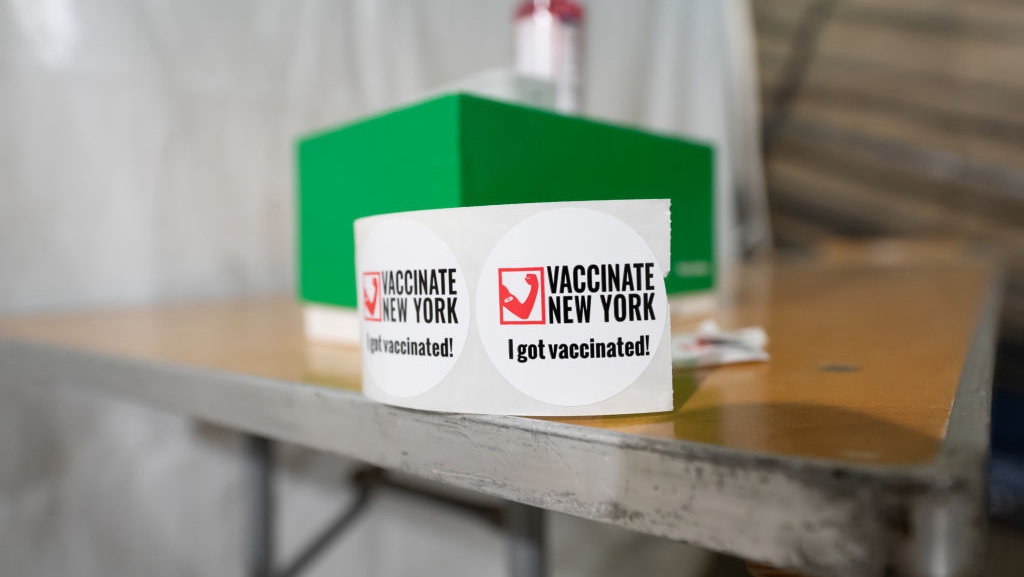
A sticker at a vaccination site inside Penn Station in New York City, May 26, 2021. /Getty
A sticker at a vaccination site inside Penn Station in New York City, May 26, 2021. /Getty
Editor's note: Simon Johnson, a former chief economist at the International Monetary Fund, is a professor at MIT's Sloan School of Management and a co-chair of the COVID-19 Policy Alliance. He is the co-author, with Jonathan Gruber, of "Jump-Starting America: How Breakthrough Science Can Revive Economic Growth and the American Dream". The article reflects the author's opinions and not necessarily the views of CGTN.
In March and April 2020, when COVID-19 first struck the United States, the virus that causes it, SARS-CoV-2, swept through U.S. nursing homes. The second phase of the crisis, from summer 2020, was marked by a drawn-out struggle to open universities and schools to in-person instruction. In the third phase, from the end of 2020, the fight has focused on getting as many vaccine doses into as many arms as possible.
What have we learned from the battle so far, and how will that experience affect what comes next for the U.S. and the world?
First, nursing homes and other congregate care settings need to remain defended at all costs. Older people are more vulnerable and cannot protect themselves in such environments by sheltering in place or staying away from other people.
Effective defenses include rapid and accurate testing for COVID-19, which the government should ensure is always available and paid for. Running a nursing home without access to adequate testing is like flying an airplane without radar: you can do it, but it is much riskier.
Second, schools can be operated in person if this is done carefully. Again, testing plays a key role. Massachusetts has pioneered a testing program for K-12 schools that supports other mitigation measures – and again provides a type of radar system for public health departments, school superintendents, and parents. When schools are closed, lower-income children and their parents suffer the most, because these families have less access to broadband internet, live in more crowded accommodations, and are employed in jobs that require them to show up in person.
Fortunately, the U.S. now has pooled testing systems that are well adapted to use in schools. And, because the Biden administration and Congress have provided $10 billion to the states to support testing in educational settings, school districts should be able to implement properly organized protocols for the fall. Working closely with the U.S. Centers for Disease Control and Prevention, the Shah Family Foundation has put together a terrific set of resources that are helping schools everywhere.

A COVID-19 test in New York City, May 26, 2021. /Getty
A COVID-19 test in New York City, May 26, 2021. /Getty
Similarly, the nonprofit Neighborhood Villages has assembled the resources necessary to run testing programs in support of childcare staff and kids. This is a breakthrough for a sector that has been much neglected, both before and during the pandemic. (The Boston-based organization's new podcast, No One is Coming to Save Us, is required listening for anyone interested in this sector's future – for example, those who have or hope to have children or grandchildren.)
Third, the pandemic is surely far from over. The disease will hit us in waves, of varying intensity, as mutations occur in far-flung corners of the world. We are more at risk when the weather cools, when flu abounds, and when we travel more. The prospect of vaccinating everyone in the world any time soon (or even reaching 5-6 billion people globally) seems increasingly remote.
Overall, we have built some impressive testing systems on the fly. The challenge now is to expand them sufficiently to cover global needs.
For example, SalivaDirect, a major public policy initiative based at Yale University's School of Public Health, has led the way in developing highly accurate and low-cost testing methods that can fit all budgets. This kind of effort needs to be scaled up.
More broadly, we urgently need a new global health system that is capable of monitoring the spread of all infectious diseases and improving access to therapeutics. But who will pay for such essential infrastructure?
After the global financial crisis of 2008, considerable resources were devoted to making the world's financial system safer. An analogous effort is needed now, both to help win the global war against COVID-19 and to ensure that nothing like this ever happens again.
Economics and finance needed a major rethink after 2008, and much of this is still a work in progress. The good news on the health side is that the knowledge base for immunology, diagnostics, and vaccines was already strong and has only improved under pressure.
What let us down in 2020 was our global public-health system – the institutions through which scientific and medical knowledge translates into care for everyone in all societies. Governments and foundations talked a good game regarding pandemic preparedness, but in fact much of what they built proved fragile and insufficient when the fog of war descended.
It is now time to do better. To some extent, this is possible by expanding the funding provided through existing channels. The National Institutes of Health did well, for example through its Rapid Acceleration of Diagnostics (RADx) initiative, which quickly expanded the supply of diagnostic tests. There is a bipartisan consensus that NIH should be given an expanded mandate in terms of developing implementable technology, backed by significant funding.
As the still-unfolding tragedy in many low-income countries attests, it is not enough for one country to get some things right. We need to focus more intensively on sharing technology and adapting practical solutions to local circumstances. The fronts in this war are many and constantly shifting. Saving lives and livelihoods requires winning on all of them.
Copyright: Project Syndicate, 2021.
(If you want to contribute and have specific expertise, please contact us at opinions@cgtn.com.)

